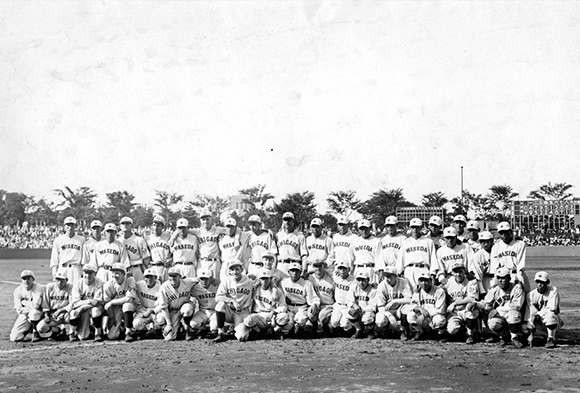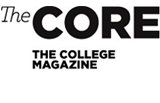
Forgotten history
Out of the ballpark
During a 1910 baseball series in Japan, UChicago demonstrated the glory of gentlemanly sports.
Bill Savage
In the autumn of 1910, the University of Chicago’s baseball team traveled to Japan at the invitation of Waseda University in Tokyo. Former Maroon baseball player Alfred Place, DB 1902, was teaching at Waseda; Place arranged the trip with his former coach, Amos Alonzo Stagg. The players took summer classes to free up their fall quarter for this exchange. The Chicagoans would learn about Japan, while the Japanese would meet American ballplayers and hone their diamond skills.

1910: Waseda University baseball team players. (UChicago Photographic Archive, apf4-00137, Special Collections Research Center, University of Chicago Library)
After their long steamship journey across the Pacific—several players were seasick—the team landed in Yokohama. Team captain Josiah James Pegues, APh 1909, SB 1910, described their first impressions: “When we were hauled thru the streets of Yokohama in ‘rickshaws,’ ... we insisted on leaving the tops of our man-drawn carriages down in spite of the steady rain; so that we might have an unobstructed view of the strange sights which surrounded us. Most novel to our eyes were the people themselves, stalking thru the mud of the narrow sidewalkless streets on stilt-like wooden clogs, and protecting their flapping skirts and kimonos from the rain with oil-paper umbrellas.”

1910: Players shake hands. (UChicago Photographic Archive, apf4-00138, Special Collections Research Center, University of Chicago Library)
The two nationalities shared a love of baseball. According to baseball researcher Robert K. Fitts, more than 35 collegiate, semipro, and professional teams crossed the Pacific to play Japanese teams between 1905 and 1934. These games were sometimes promoted by Japanese newspapers looking to boost circulation or by American entrepreneurs looking to raise the national pastime’s international profile—and potential for profit. The UChicago and Waseda teams visited each other at five-year intervals into the 1930s.

1921: The Waseda University baseball team. (UChicago Photographic Archive, apf4-00148, Special Collections Research Center, University of Chicago Library)
Souvenirs of the 1910 trip reside in the Special Collections Research Center at Regenstein: postcards collected by Frederick “Fritz” Steinbecher, PhB 1913, and a scrapbook compiled by Glen S. Roberts, APh 1911, PhB 1912. From our contemporary perspective, where Major League Baseball with its vast money and win-at-any-cost ethos dominates, it’s remarkable what the participants found most memorable: fair play, etiquette, and amateurism.

1930: The UChicago baseball team departs by train from Chicago to Seattle, where they set sail for Japan. (UChicago Photographic Archive, apf4-00159, Special Collections Research Center, University of Chicago Library)
The history of Maroon baseball doesn’t get a fraction of the attention given to football, but perhaps it should. Stagg’s prominence in the history of college football obscures his other roles. He was not just the football coach, but director of the Department of Physical Culture; he also coached track and baseball for many years. Stagg’s athletes excelled on the diamond, winning Big Ten championships in 1896, 1897, 1898, and 1913.

1930: The UChicago baseball players in Japan. (UChicago Photographic Archive, apf4-00162, Special Collections Research Center, University of Chicago Library)
The 1910 baseball squad won all 10 of their games in Japan, inspiring these headlines in a Tokyo English-language paper:
“Keio Fall before Classy Chicagoites; Premier Japanese Team Meets Superiors at National Game”
“Chicago Wins First International Game; Midway Team Defeats Waseda in Opening Match; Friendly and Clean Contest; Superior Batting of the American Players Spells Downfall for the Local Boys.”
Chicago’s victory, Pegues wrote, “was somewhat of a surprise to the Japanese as they had confidently expected to beat us.”
An anonymous editorialist in Mainichi Dampo writes:
“In the United States, the East claims almost a monopoly of politeness and refinement. The West is generally considered as rough and unrefined.”
Yet the “Western” Chicagoans were gentlemen.
“But from this West we had the pleasure and satisfaction of welcoming here a baseball team most exemplary not only in the skill of the art, but also in their conduct on the field,” which was “entirely beyond reproach even in minor details” as “not a word of indecent language came out of their lips.”

1930: The UChicago and Waseda University baseball teams in Japan. (UChicago Photographic Archive, apf4-00161, Special Collections Research Center, University of Chicago Library)
Such proper behavior was not associated with baseball. In the early decades of the professional game—in 1910 the American League was only 10 years old and the original Comiskey Park newly opened—it was mostly considered a rude pursuit, played by unlettered ruffians for crowds of truant urchins, idling ne’er-do-wells, and gamblers. The collegiate game preserved, so the elitist reasoning went, ideals of amateurism and gentlemanly fair play. Stagg relentlessly promoted such amateurism, but baseball was problematic for him. Unlike his football players, collegiate baseball players would have professional opportunities every summer in the many minor leagues all over the country.

Undated: The Waseda University baseball team. (UChicago Photographic Archive, apf4-00154, Special Collections Research Center, University of Chicago Library)
But Stagg must have recruited well, since his players shared this attitude. Pegues complimented the Maroons’ Japanese opponents: “The Japanese seem to believe in sport for sport’s sake alone, and prefer to support contests by contribution rather than by paid admission to the field of play.”
One day the Chicago players went sightseeing around Tokyo. They discovered in the Ginza shopping district they could purchase postcards of the game they had played the day before.

1910: The UChicago team at Kamakura, Japan, in front of the great bronze of Amida (Daibutsu). (UChicago Photographic Archive, apf4-00142, Special Collections Research Center, University of Chicago Library)
The cards feature crowd shots and formally posed team pictures as well as action photos that would almost allow us to recreate parts of the games (if we had scorecards or more detailed accounts to work from). Some cards have Japanese captions, while others identify the action as “The Bace Ball of the Waseda and Cicago.”
In Roberts’s jam-packed scrapbook, another striking aspect of this trip emerges. When the Chicagoans arrived in Japan, they were met dockside by Waseda players chanting the Chicago yell: “Chica-go-go-go!”
When the Waseda team returned the Maroons’ visit in 1911, the Chicago players returned the favor. They had learned to sing the Waseda fight song by memorizing it phonetically.
Northwestern University associate professor Bill Savage specializes in literature, Chicago history, and baseball. His annotated edition of George Ade’s 1931 book The Old-Time Saloon: Not Wet—Not Dry, Just History (University of Chicago Press) will be published this fall.
